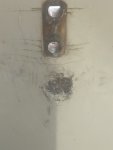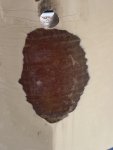Bassmaster229
Cadet
- Joined
- Aug 8, 2020
- Messages
- 13
I have a 2000 Carolina skiff 1965 V series with damage bellow the bow eye. Iooking for repair advice. First thing I noticed is behind the damage in the hole there is some pretty thick woven fiberglass. It’s hard to see in the pic but if you zoom in you can kind of make it out. Aren’t these things built with a chopper gun? So if there is woven glass could this area have been repaired before? I started to grind out the damaged glass. As I tried to feather the edges out I hit an open area towards the bottom of the hull where the V shape starts. My first thought was delamination. But all that’s behind it is that woven fiberglass and it’s flat. Not V shaped. Could i be seeing the floor behind the hull? How thick is the hull in this area. Final question. I know epoxy repairs are stronger but I want to be able to gel coat. So would the polyester resin work for this repair? What repair process would you use for this? Any advice is appreciated. I’ve done a little fiberglass before but never on a boat.





















